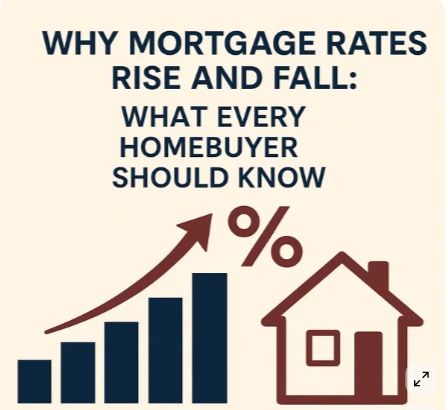What Drives Mortgage Rates—and How You Can Respond Strategically
Understanding what influences mortgage rates empowers both buyers and homeowners to make better financial decisions—whether you're looking to purchase, refinance, or simply stay informed. Rates are shaped by a mix of national economic trends and personal borrower factors. Here’s what to know:
What Determines Mortgage Rates?
1. Market Conditions
- 10-Year Treasury Yield: Mortgage rates tend to track closely with the 10-year U.S. Treasury yield. When yields rise, rates typically increase as well.
- Mortgage-Backed Securities (MBS): These securities, bought and sold by investors, influence how lenders price mortgages. Greater demand for MBS often pushes mortgage rates down.
2. Economic Factors
- Inflation: Higher inflation erodes purchasing power, so rates often increase to compensate investors.
- Federal Reserve Policy: While the Fed doesn’t set mortgage rates directly, its actions—like adjusting the federal funds rate—impact the bond market and, by extension, mortgage pricing.
- Economic Outlook: Strong job reports or GDP growth can lead to higher rates, while signs of a slowdown usually bring rates down.
- Geopolitical Instability: Global unrest often leads investors to seek the relative safety of U.S. Treasury securities, which can drive yields down and, in turn, lower mortgage rates.
3. Your Profile as a borrower
- Credit Score: A score of 740+ typically unlocks the most favorable rates.
- Down Payment & Loan-to-Value (LTV): The more you put down, the lower your LTV—and the lower your risk in the eyes of lenders.
- Debt-to-Income (DTI) Ratio: Lower DTI ratios suggest better ability to repay and can improve your rate.
- Property Type & Occupancy: Rates are generally lower for primary residences and single-family homes than for investment properties or second homes.
4. Lender-Specific Factors
Lenders may adjust their rates based on market competition, loan volume, or internal risk strategy. Working with a broker allows you to compare across multiple lenders to find the best fit.
5. Loan Program Type
- Loan Term: Shorter terms (e.g., 15-year) usually offer lower interest rates than 30-year loans.
- Fixed vs. Adjustable Rates: Fixed-rate loans offer stability, while ARMs typically start lower but may rise later.
- Government-Backed Loans: FHA, VA, and USDA loans may offer lower rates due to government guarantees.
How Homeowners Can Navigate Rate Trends
While you can’t control the market, you can control how prepared you are. Here’s how to position yourself:
Monitor—but Don’t Wait Forever
Rates fluctuate daily. If you're in the market to buy or refinance, stay informed and be ready to act when a rate aligns with your goals.
-
Improve Your Credit -
Small increases in your credit score can make a noticeable difference in rate and loan costs. Pay down revolving debt, avoid new inquiries, and make timely payments.
- Increase Your Down Payment -
A larger down payment can improve your rate, reduce mortgage insurance, and lower monthly payments.
-
Explore Rate Buydowns -
Consider whether a temporary buydown (like a 2-1 buydown) or permanent points make more sense for your situation. A mortgage broker can model both options for comparison.
-
Lock at the Right Time - Talk to your loan officer about rate lock timing. For buyers under contract, it’s crucial to evaluate locking now versus floating. Some extended lock options are also available.
-
Match the Loan Term to Your Plans -
If you expect to sell or refinance in a few years, a shorter-term loan or adjustable-rate mortgage might offer lower payments and long-term savings.
Final Thoughts
Mortgage rates are shaped by forces far beyond your control—but how you respond is entirely within your power. From improving your credit to choosing the right loan structure, small decisions can lead to significant long-term savings.